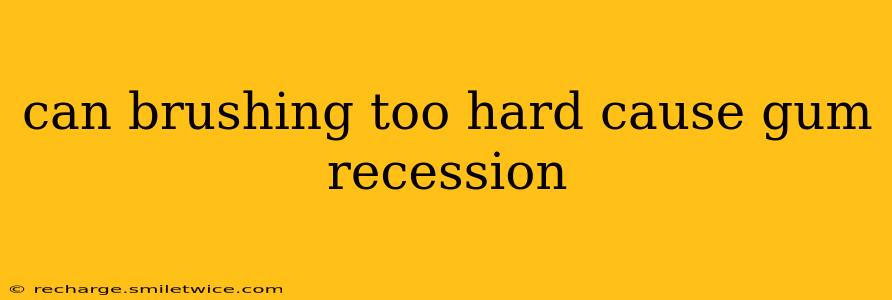Can Brushing Too Hard Cause Gum Recession?
Yes, brushing your teeth too hard is a significant contributor to gum recession. Gum recession is the process where your gums pull back, exposing more of your tooth and potentially the roots. This isn't just an aesthetic issue; it leaves your teeth vulnerable to sensitivity, decay, and even tooth loss. Understanding the mechanics behind this damage is crucial to maintaining healthy gums and a bright smile.
What Happens When You Brush Too Hard?
Aggressive brushing, even with a soft-bristled toothbrush, can cause microscopic abrasions on your gum tissue. This constant abrasion irritates the gums, leading to inflammation (gingivitis). Over time, this inflammation can damage the tissues supporting your teeth, causing the gums to recede. Think of it like repeatedly rubbing your skin—eventually, it becomes raw and irritated. Your gums react similarly to excessive brushing pressure.
What are the Signs of Gum Recession?
Recognizing the early signs of gum recession is vital for preventing further damage. Look out for:
- Noticeably longer-appearing teeth: This is a primary indicator that your gums are receding.
- Sensitivity to hot and cold: Exposed tooth roots lack the protective enamel of the crown, making them highly sensitive to temperature changes.
- Bleeding gums: While some bleeding is normal, persistent bleeding after brushing is a sign of gum irritation and potential recession.
- Loose teeth: In advanced cases, gum recession can weaken the support structures of your teeth, leading to looseness.
- Notches or V-shaped indentations in your gums: These are often visible near the gum line and are clear signs of gum recession.
How Can I Tell If I'm Brushing Too Hard?
Many people are unaware of how hard they're brushing. Here's how to check:
- Pay attention to the feeling: Brushing shouldn't feel abrasive or scratchy. If it does, you're likely brushing too hard.
- Examine your toothbrush bristles: Frayed or splayed bristles are a telltale sign of excessive pressure. Replace your brush every 3-4 months, or sooner if the bristles are damaged.
- Observe your gums: Redness, swelling, or bleeding after brushing suggests you need to be gentler.
What are the other causes of gum recession?
While aggressive brushing is a major factor, other causes contribute to gum recession:
- Genetics: Some individuals are predisposed to gum recession due to their genetic makeup.
- Gum disease (periodontitis): This bacterial infection inflames and destroys the tissues supporting your teeth, leading to recession.
- Aggressive toothbrushing techniques: Incorrect brushing techniques, even with gentle pressure, can still damage gums.
- Grinding or clenching your teeth (bruxism): This puts extra stress on your teeth and gums.
- Hormonal changes: Fluctuations in hormones, especially during pregnancy or menopause, can increase gum sensitivity and susceptibility to recession.
- Smoking: Smoking impairs blood flow to the gums, hindering their ability to heal and increasing the risk of recession.
- Certain medical conditions: Some medical conditions can increase the risk of gum recession.
How Can I Prevent Gum Recession?
Preventing gum recession involves adopting healthy oral hygiene habits:
- Use a soft-bristled toothbrush: Soft bristles are less likely to cause damage to your gums.
- Brush gently in small circular motions: Avoid scrubbing back and forth.
- Don't brush too vigorously: Use gentle pressure. Think of massaging your gums rather than scrubbing them.
- Brush twice a day for two minutes each time: Consistent brushing is essential for removing plaque and preventing gum disease.
- Floss daily: Flossing removes plaque from between your teeth, where your toothbrush can't reach.
- See your dentist regularly: Regular checkups and professional cleanings are crucial for maintaining gum health.
By understanding the causes and prevention strategies, you can protect your gums and maintain a healthy smile for life. Remember, a gentle touch goes a long way in preventing gum recession. If you're concerned about gum recession, schedule an appointment with your dentist for a professional evaluation.
